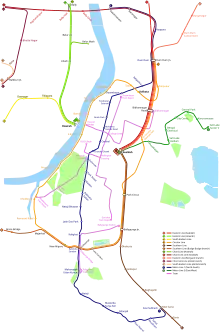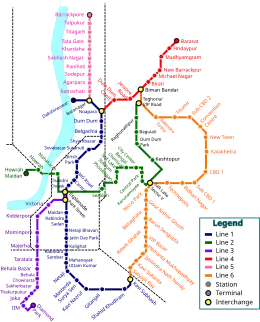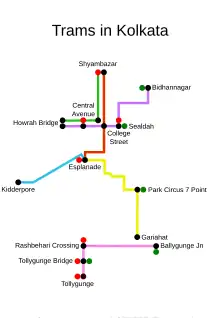Public transport in Greater Kolkata
Greater Kolkata has one of the most extensive public transport networks in India. The diverse modes of public transport in the region ranges from the modern rapid transit system to the old heritage tram system.

Understand
Ferries, local trains and trams are one of the oldest modes of public transport in Greater Kolkata. Before the construction of road bridges over the Hooghly River, ferries were heavily used to transport between the two banks of the river. The ferries are still used to cross the river, mainly for sightseeing and to avoid the traffic on the bridges.
The first passenger railway service in Eastern India began on 15 August 1854 on its first run between Howrah to Hooghly. The service gradually evolved into the present-day Kolkata Suburban Railway Network. The trains were used to run in steam, but they were replaced by electric multiple units (EMUs) by the 1950s–60s.
Kolkata's tram system was opened in 1872. The trams were used to run by horses and steam, but they were replaced by electric trams by 1902. The tram network had up to 37 routes in the 1960s, but it has gradually reduced to only six routes operating as of 2024. The reasons cited include financial struggles, poor maintenance, low ridership, the addition of road flyovers, expansion of metro, slow tram speed and perceptions that the trams are outdated and occupy too much road space.
Bus services in Kolkata started in 1920, which was reorganised into 6 intracity routes with a fleet of 25 buses in 1948. The bus services were used to run by three companies, namely Calcutta State Transport Corporation (CSTC), Calcutta Tramways Company (CTC) and West Bengal Surface Transport Corporation (WBSTC). The three companies were merged into West Bengal Transport Corporation (WBTC) by 2016.
Bus
.jpg.webp)
The bus network around Greater Kolkata is possibly the most exhaustive in the whole of India and it is the cheapest, though not always the most comfortable means of transport. The routes are written all over the colourful buses in Bengali and also in English. The conductors call out their destinations to everyone they are passing and all you have to do is wave at the bus anywhere and it will stop, at times causing a small queue of other cars behind it. Buses in Kolkata, Howrah and other parts of West Bengal do not have a card system. One has to buy tickets after boarding the bus. The bus tickets are simple paper tickets purchased from the bus conductor.
You can travel 20 km at around ₹10. The exact fare depends on the type of bus. There are both state-run and private buses that ply the city streets.
State-run buses
State-run buses in Greater Kolkata are operated by West Bengal Transport Corporation (WBTC). These buses are generally painted blue and are identified by the acronym WBTC on the front windscreen and on their body. Non-air-conditioned buses fare start from ₹10 whereas air-conditioned buses fare start from ₹25. WBTC also provides some special transport services on some occasions, like Gangasagar Mela, Durga Puja, Kolkata Book Fair and so on.
West Bengal Tourism operates a pair of double-decker tourist buses from Rabindra Sadan to Jorasanko during festive seasons. These buses are identified with blue and white shades and the roofless (Bengali: হুডখোলা, huḍkholā) upper deck. The ticket costs ₹649 per head for the upper deck and ₹499 per head for the lower deck.
Private buses
Private buses are run by private operators who are affiliated with bus unions. They are of three types:
- Regular buses: Coloured blue and yellow.
- Short-distance buses (SD): Coloured blue and white.
- Minibuses: Coloured red and yellow but contains fewer seats.
Termini
The bus termini in Greater Kolkata are:
- 🌍 Babughat Bus Terminus, ~8 Strand Rd. One of the main bus termini in Kolkata alongside Esplanade. One can find interstate buses going into Bihar, Jharkhand, Odisha and other cities of West Bengal. (updated Sep 2022)
- 🌍 Barasat Bus Terminus, Champadali. (updated Sep 2022)
- 🌍 Howrah Bus Terminus (W of the Howrah Bridge, N of Howrah station). Buses are available from Howrah and different parts of West Bengal. (updated Oct 2022)
- 🌍 Esplanade Bus Terminus (Dharmatala Bus Stand). It has bus terminals for buses from Bangladesh, Bhutan, Sikkim, Odisha, Jharkhand, Bihar and other parts of the country. (updated Aug 2022)
- 🌍 International Bus Terminus, Karunamoyee, Sector-III, Bidhannagar. The Kolkata-Dhaka bus service operates from here. (updated Oct 2022)
- 🌍 Kolkata Central Bus Terminus (Santragachi Bus Stand) (outside Santragachi station). (updated Oct 2022)
- 🌍 Nabanna Bus Terminus, Andul Rd. (updated Oct 2022)
Ferry

The ferry services to cross the Hooghly River from Kolkata to Howrah is very convenient to zip across both cities. The Hooghly River offers a less crowded but slow traffic medium. There are several points (popularly called ghats and jetties) on the bank of the river from where you can board several regular routes of ferry services. Operated by the West Bengal Transport Corporation (WBTC), the ferries can be fairly large launches to small improvised motorised boats. Even if you don't get any exotic manual boat like you get in Varanasi, the river transport of Greater Kolkata lets you go to several old spots near the bank in a hassle-free manner with an additional dash of the view of decadent riverfront of the cities.
Buy the ticket before you board the ferry and retain the ticket till after you have crossed to the other side and have shown it to the ticket checker near the exit gate or else you will be penalised!
| Ferry ghat | Services | Connections | Other information |
|---|---|---|---|
| Ahiritola Ghat | Bagbazar–Howrah Sovabazar–Howrah | ||
| Armenian Ghat | Howrah–Armenian Ghat | ||
| Babughat | Babughat–Howrah Babughat–Ramkrishnapur | ||
| Bagbazar | Bagbazar–Howrah Fairlie Place–Bagbazar Uttarpara–Bagbazar | ||
| Dakshineswar | Belur Math–Dakshineswar | 1 Dakshineswar | |
| Fairlie Place | Fairlie Place–Bagbazar Fairlie Place–Chandpal Ghat Fairlie Place–Kuthi Ghat Fairlie Place–Metiabruz Fairlie Place–Uttarpara | ||
| Howrah | Babughat–Howrah Bagbazar–Howrah Howrah–Armenian Ghat Howrah–Uttarpara Sovabazar–Howrah | ||
| Kuthi Ghat | Fairlie–Kuthi Ghat Kuthi Ghat–Belur | ||
| Outram Ghat | |||
| Prinsep Ghat | |||
| Sovabazar | Bagbazar–Howrah Sovabazar–Howrah |
Metro
.jpg.webp)

The oldest rail rapid transit system in India, the Kolkata Metro is the fastest, cleanest, most reliable and most efficient of all the transport Kolkata has to offer. Trains run every 5 minutes (rush hours) to 15 minutes (non-rush hours) from 6:55AM-10:30PM from Monday to Saturday and 9:50AM-10:00PM on Sunday. Fares range from ₹5-30.
The four-seat sections at each end of a coach are reserved for senior citizens and the physically challenged. The two middle seat sections, between the general seat sections on each side, are reserved for women. Smoking is also strictly prohibited on the metro premises. Violating any of these incurs a penalty.
Be aware that if you wish to exit at a station during rush hours, you will have to tackle your way through in order to get out before the opposite flow of passengers pushes you back inside. Don't be afraid of using your strength to push yourself out.
Lines
As of 2024, the lines 1, 2, 3 and 6 are operational.
| Name | Status | Termini | Other information | |
|---|---|---|---|---|
| Operational | Proposed | |||
| North–South Metro (Blue Line) 1 |
Operational | Dakshineswar–Kavi Subhash (New Garia) | The oldest metro line of Kolkata. | |
| East–West Metro (Green Line) 2 |
Partly operational | Howrah Maidan–Esplanade | Howrah Maidan–Teghoria | The line is divided into Howrah Maidan–Esplanade and Sealdah–Salt Lake Sector V sections. The Howrah Maidan–Esplanade section is the first underwater metro service of India. |
| Sealdah–Salt Lake Sector V | ||||
| Purple Line 3 | Partly operational | Majerhat–Joka | Esplanade–Diamond Park | |
| Yellow Line 4 | Under construction | Noapara–Barasat | ||
| Pink Line 5 | Proposed | Barrackpore–Baranagar | ||
| Orange Line 6 | Partly operational | Hemanta Mukhopadhyay (Ruby)–Kavi Subhash (New Garia) | Jai Hind (Airport)–Kavi Subhash (New Garia) | |
Stations
Only operational stations are listed here.
North–South Metro
| Name | Location | Connections | Other information |
|---|---|---|---|
| Baranagar | Baranagar | ||
| Belgachia | North Kolkata | ||
| Central | Central Kolkata | ||
| Chandni Chowk | Central Kolkata | ||
| Dakshineswar | Dakshineswar | ||
| Dum Dum | Dum Dum | ||
| Esplanade | Esplanade | ||
| Girish Park | North Kolkata | ||
| Gitanjali | South Kolkata (Naktala) | ||
| Jatin Das Park | South Kolkata (Hazra) | ||
| Kalighat | South Kolkata | ||
| Kavi Nazrul | East Kolkata (Garia Bazar) | ||
| Kavi Subhash | East Kolkata (New Garia) | ||
| Mahanayak Uttam Kumar | South Kolkata (Tollygunge) | ||
| Mahatma Gandhi Road | North Kolkata | ||
| Maidan | Maidan | ||
| Masterda Surya Sen | South Kolkata (Bansdroni) | ||
| Netaji | South Kolkata (Kudghat) | ||
| Netaji Bhavan | South Kolkata (Bhowanipore) | ||
| Noapara | Baranagar | ||
| Park Street | Central Kolkata | ||
| Rabindra Sadan (Exide) | South Kolkata | ||
| Rabindra Sarobar | South Kolkata (Charu Market) | ||
| Shahid Khudiram | East Kolkata (Dhalai Bridge) | ||
| Shobhabazar Sutanuti | North Kolkata | ||
| Shyambazar | North Kolkata |
East–West Metro
| Name | Location | Connections | Other information | |
|---|---|---|---|---|
| Bengal Chemical | East Kolkata | |||
| Central Park | East Kolkata | |||
| City Center | East Kolkata | |||
| Esplanade | Esplanade | |||
| Howrah | Howrah | |||
| Howrah Maidan | Howrah | |||
| Karunamoyee | East Kolkata | 2 | ||
| Phoolbagan | East Kolkata | |||
| Salt Lake Sector V | East Kolkata | |||
| Salt Lake Stadium | East Kolkata | |||
| Sealdah | North Kolkata |
Purple Line
| Name | Location | Connections | Other information | |
|---|---|---|---|---|
| Behala Bazar | South Kolkata | |||
| Behala Chowrasta | South Kolkata | |||
| Joka | South Kolkata | 3 | ||
| Mahakaran | Esplanade (B. B. D. Bagh) | |||
| Majerhat | South Kolkata | Majerhat | ||
| Sakherbazar | South Kolkata | |||
| Taratala | South Kolkata | |||
| Thakurpukur | South Kolkata |
Orange Line
| Name | Location | Connections | Other information |
|---|---|---|---|
| Hemanta Mukhopadhyay | East Kolkata (Ruby) | ||
| Jyotirindra Nandi | East Kolkata (Mukundapur) | ||
| Kavi Subhash | East Kolkata (New Garia) | ||
| Kavi Sukanta | East Kolkata (Kalikapur) | ||
| Satyajit Ray | East Kolkata (Ajay Nagar) |
Local Train
- See also: Rail travel in India

Greater Kolkata is part of both the Eastern Railway (ER) and the South Eastern Railway (SER) zone. The region is served by both passenger and suburban railway services. The Kolkata Suburban Railway, commonly referred to as "local trains", has the largest suburban railway network in India. The suburban trains are identified by its white-pink livery, and depending on the route, such trains can be extremely crowded. It is less expensive to travel around by train as compared to private taxis.
There are five lines under the suburban railway network, including the Chord Link Line, Circular Railway, Eastern Line, Sealdah South and the South Eastern Line.
Kolkata Circular Railway
The Kolkata Circular Railway Circular is a railway loop line around Kolkata, which begins and terminates at Dum Dum Junction railway station. The line mostly runs along the Hooghly River and through the city centre. The Circular Railway offers direct interchange points with the North–South Metro at Dum Dum and Tollygunge railway stations, while connecting multiple tourist places and ghats, for example Prinsep Ghat and the Eden Gardens. It provides a scenic view for daily commuters and visitors.
From Dum Dum Junction to Tala, the line is double-tracked, while from Tala to Majerhat, the line is single-tracked. Running by the side of the Hooghly River from Tala to Majerhat, it joins and runs parallel to the Sealdah South tracks after Majerhat and elevates at Park Circus in order to bypass Sealdah (which is a terminal station). After bypassing Sealdah, it rejoins the mainline at Bidhannagar Road and again terminating at Dum Dum Junction.
| Station name | Station code | Location | Connections | Other information |
|---|---|---|---|---|
| Ballygunge | BLN | South Kolkata | ||
| B.B.D Bag | BBDB | Esplanade | ||
| Dum Dum Junction | DDJ | Dum Dum | 1 Dum Dum | |
| Eden Gardens | EDG | Maidan | ||
| Kolkata | KOAA | North Kolkata | ||
| Majerhat | MJT | Southwest Kolkata | ||
| Prinsep Ghat | PPGT | Maidan | ||
| Tala | TALA | North Kolkata | ||
| Tollygunge | TLG | South Kolkata | 1 Rabindra Sarobar |
Tram


Kolkata has the only tram service in all of India and the oldest surviving electric tram network in Asia. Though decommissioned in some parts of the city, electric trams are still one of the means of travelling between a few places within the city. They move slowly on the laid tracks in traffic-jammed streets, but they are environment-friendly (no emissions on the street, only at the source of energy generation). The trams were operated by the Calcutta Tramways Company (CTC) until 2016 when the company merged into the West Bengal Transport Corporation (WBTC).
The tram network had up to 37 routes in the 1960s, but it has gradually reduced to only six routes operating as of 2024:
- Route No. 5: Esplanade–Shyambazar
- Route No. 11: Howrah Bridge–Shyambazar
- Route No. 18: Howrah Bridge–Bidhannagar
- Route No. 24/29: Ballygunge Jn–Tollygunge
- Route No. 25: Esplanade–Gariahat
Stay safe
Water-logging, caused by heavy rains during the summer monsoon, often interrupt transport networks. Keep yourself updated with the latest weather news before venturing out to use public transport.